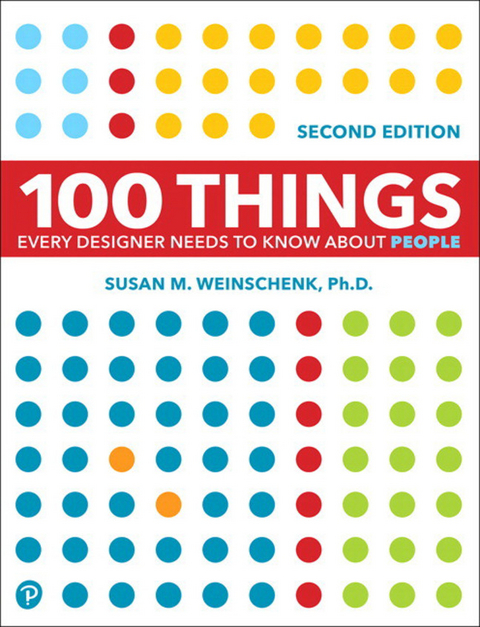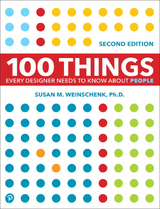100 Things Every Designer Needs to Know About People
New Riders Publishing (Verlag)
978-0-13-674691-1 (ISBN)
Here are some of the questions this book will answer:
What grabs and holds attention?
What makes memories stick?
What motivates people?
How does listening to music make people feel?
How do you engineer a decision?
What line length for text is best?
Are some fonts better than others?
We design to elicit responses from people. We want them to buy something, read more, or take action of some kind. Designing without understanding what makes people act the way they do is like exploring a new city without a map: results will be haphazard, confusing, and inefficient. Increase the effectiveness of your designs by using science-backed examples on human behavior.
"Every once in a while, a book comes along that is so well-written, researched, and designed that I just can't put it down. That's how good 100 Things Every Designer Needs to Know About People is!"
—Lynne Cooke, Clinical Assistant Professor at Arizona State University
Susan M. Weinschenk has a Ph.D. in Psychology and is the Chief Behavioral Scientist and the CEO at The Team W, Inc. She is a consultant to Fortune 1000 companies, start-ups, governments and non-profits. Dr. Weinschenk is also an Adjunct Professor at the University of Wisconsin.
How People See
1. What You See Isn't What Your Brain Gets
2. Peripheral Vision Is Used More Than Central Vision to Get the Gist of What You See
3. People Identify Objects by Recognizing Patterns
4. There's a Special Part of the Brain Just for Recognizing Faces
5. There Is a Special Part of the Brain for Processing Simple Visual Features
6. People Scan Screens Based on Past Experience and Expectations
7. People See Cues That Tell Them What to Do with An Object
8. People Can Miss Changes in Their Visual Fields
9. People Believe That Things That Are Close Together Belong Together
10. Red and Blue Together Are Hard on the Eyes
11. Nine Percent of Men and One-Half Percent of Women Are Color-Blind
12. The Meanings of Colors Vary by Culture How People Read
How People Read
13. It's a Myth That Uppercase Letters Are Inherently Hard to Read
14. Reading and Comprehending Are Two Different Things
15. Pattern Recognition Helps People Identify Letters in Different Fonts
16. Font Size Matters
17. Reading a Screen Is Harder Than Reading Paper
18. People Read Faster with a Longer Line Length, But They Prefer a Shorter Line Length
How People Remember
19. Short-Term Memory Is Limited
20. People Remember Only Four Items at Once
21. People Have to Use Information to Make It Stick
22. It's Easier to Recognize Information Than Recall It
23. Memory Takes a Lot of Mental Resources
24. People Reconstruct Memories Each Time They Remember Them
25. It's a Good Thing That People Forget
26. The Most Vivid Memories Are Wrong
How People Think
27. People Process Information Better in Bite-Sized Chunks
28. Some Types of Mental Processing Are More Challenging Than Others
29. Minds Wander 30 Percent of the Time
30. The More Uncertain People Are, the More They Defend Their Ideas
31. People Create Mental Models
32. People Interact with Conceptual Models
33. People Process Information Best in Story Form
34. People Learn Best from Examples
35. People Are Driven to Create Categories
36. Time Is Relative
37. People Screen Out Information That Doesn't Fit Their Beliefs
38. People Can Be in a Flow State
39. Culture Affects How People Think
How People Focus Their Attention
40. Attention Is Selective
41. People Habituate Information
42. Well-Practiced Skills Don't Require Conscious Attention
43. Expectations of Frequency Affect Attention
44. Sustained Attention Lasts About Ten Minutes
45. People Pay Attention Only to Salient Cues
46. People Are Worse at Multitasking Than They Think
47. Danger, Food, Sex, Movement, Faces, and Stories Get the Most Attention
48. Loud Noises Startle and Get Attention
49. For People to Pay Attention to Something, They Must First Perceive It
What Motivates People
50. People Are More Motivated as They Get Closer to a Goal
51. Variable Rewards Are Powerful
52. Dopamine Stimulates the Seeking of Information
53. Unpredictability Keeps People Searching
54. People Are More Motivated by Intrinsic Rewards Than Extrinsic Rewards
55. People Are Motivated by Progress, Mastery, and Control
56. People Are Motivated by Social Norms
57. People Are Inherently Lazy
58. People Will Look for Shortcuts Only If the Shortcuts Are Easy
59. People Assume It's You, Not the Situation
60. Forming or Changing a Habit Is Easier Than You Think
61. People Are More Motivated to Compete When There Are Fewer Competitors
62. People Are Motivated by Autonomy
People Are Social Animals
63. The “Strong Tie” Group Size Limit Is 150 People
64. People Are Hard Wired for Imitation and Empathy
65. Doing Things Together Bonds People Together
66. People Expect Online Interactions to Follow Social Rules
67. People Lie to Differing Degrees Depending on the Medium
68. Speakers' Brains and Listeners' Brains Sync Up During Communication
69. The Brain Responds Uniquely to People You Know Personally
70. Laughter Bonds People Together
71. People Can Tell When a Smile Is Real or Fake More Accurately with Video
How People Feel
72. Some Emotions May Be Universal
73. Positive Feelings about a Group Can Lead to Groupthink
74. Stories and Anecdotes Persuade More Than Data Alone
75. If People Can't Feel, Then They Can't Decide
76. People Are Programmed to Enjoy Surprises
77. People Are Happier When They're Busy
78. Pastoral Scenes Make People Happy
79. People Use "Look and Feel" as Their First Indicator of Trust
80. Listening to Music Releases Dopamine in the Brain
81. The More Difficult Something Is to Achieve, the More People Like It
82. People Overestimate Reactions to Future Events
83. People Feel More Positive Before and After an Event Than During It
84. People Want What Is Familiar When They Are Sad or Scared
People Make Mistakes
85. People Will Always Make Mistakes; There Is No Fail-Safe Product
86. People Make Errors When They Are Under Stress
87. Not All Mistakes Are Bad
88. People Make Predictable Types of Errors
89. People Use Different Error Strategies
How People Decide
90. People Make Most Decisions Unconsciously
91. The Unconscious Knows First
92. People Want More Choices and Information Than They Can Process
93. People Think Choice Equals Control
94. People May Care About Time More Than They Care About Money
95. Mood Influences the Decision- Making Process
96. You Can Engineer Better Group Decisions
97. People Make Habit-Based Decisions or Value-Based Decisions, but Not Both at the Same Time
98. When People Are Uncertain, They Let Others Decide What to Do
99. People Think Others Are More Easily Influenced Than They Are Themselves
100. People Value a Product More Highly When It's Physically in Front of Them
| Erscheinungsdatum | 29.07.2020 |
|---|---|
| Reihe/Serie | Voices That Matter |
| Sprache | englisch |
| Maße | 173 x 232 mm |
| Gewicht | 400 g |
| Themenwelt | Kunst / Musik / Theater ► Design / Innenarchitektur / Mode |
| Geisteswissenschaften ► Psychologie ► Arbeits- und Organisationspsychologie | |
| Informatik ► Grafik / Design ► Desktop Publishing / Typographie | |
| Informatik ► Web / Internet ► Web Design / Usability | |
| ISBN-10 | 0-13-674691-8 / 0136746918 |
| ISBN-13 | 978-0-13-674691-1 / 9780136746911 |
| Zustand | Neuware |
| Informationen gemäß Produktsicherheitsverordnung (GPSR) | |
| Haben Sie eine Frage zum Produkt? |
aus dem Bereich




